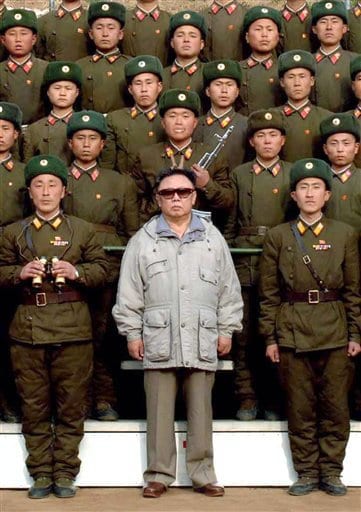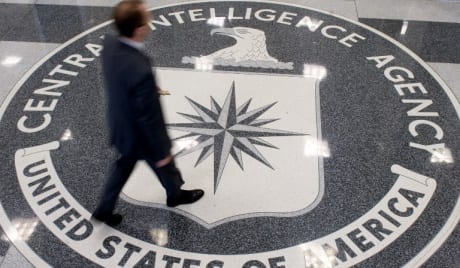By Stephen Gowans

Is North Korea’s recent nuclear test, its third, to be welcomed, lamented or condemned? It depends on your perspective. If you believe that a people should be able to organize their affairs free from foreign domination and interference; that the United States and its client government in Seoul have denied Koreans in the south that right and seek to deny Koreans in the north the same right; and that the best chance that Koreans in the north have for preserving their sovereignty is to build nuclear weapons to deter a US military conquest, then the test is to be welcomed.
If you’re a liberal, you might believe that the United States should offer the DPRK (the Democratic People’s Republic of Korea, North Korea’s official name) security guarantees in return for Pyongyang completely, permanently and verifiably eliminating its nuclear weapons program. If so, your position invites three questions.
• Contrary to the febrile rhetoric of high US officials, the United States is not threatened by North Korea. North Korea’s nuclear weapons capability is a defensive threat alone. The DPRK’s leaders are not unaware that a first-strike nuclear attack would trigger an overwhelming US nuclear retaliatory strike, which, as then US president Bill Clinton once warned, “would mean the end of their country as we know it”. Since a North Korean first-strike would be suicidal (and this is not lost on the North Korean leadership), whether Pyongyang has or doesn’t have nuclear weapons makes little difference to US national security. What, then, would motivate Washington to offer genuine security guarantees? It can’t be argued that US national security considerations form the basis of the guarantees, since the threat to the United States of a nuclear-armed North Korea is about the same as a disarmed North Korea—approximately zero.
• How credible could any security guarantee be, in light of the reality that since 1945 Washington has invested significant blood and treasure in eliminating all expressions of communism and anti-imperialism on the Korean peninsula. The argument that the United States could issue genuine security guarantees would have to explain what had transpired to bring about a radical qualitative shift in US policy from attempting to eliminate communism in Korea to détente with it.
• Why is it incumbent on North Korea alone to disarm? Why not the United States too?
The conservative view, on which I shall not tarry, is simple. Anything North Korea does, except surrender, is blameworthy.
Finally, you might lament Pyongyang’s nuclear test for running counter to nuclear non-proliferation, invoking the fear that growth in the number of countries with nuclear weapons increases the risk of war. But this view crumbles under scrutiny. The elimination of weapons of mass destruction (WMDs) in Iraq didn’t reduce the chances of US military intervention in that country—it increased them. Libyan leader Muammar Gaddafi’s voluntary elimination of his WMD didn’t prevent a NATO assault on Libya—it cleared the way for it. The disarming of countries that deny the US ruling class access to markets, natural resources, and investment opportunities, in order to use these for their own development, doesn’t reduce the risk of wars of conquest—it makes them all the more certain.
The radical view locates the cause of wars of conquest since the rise of capitalism in the drive for profits. This compulsion chases the goods, services and capital of corporate-dominated societies over the face of the globe to settle everywhere, nestle everywhere, and establish connections everywhere, irrespective of the wishes, interests, development needs and welfare of the natives. If territories aren’t voluntarily opened to capital penetration through trade and investment agreements, their doors are battered down by the Pentagon, the enforcer of last resort of a world economic order supporting, as its first commitment, the profit-making interests of the US ruling class.
Background
Because North Korea has long been vilified and condemned by the Western press as bellicose, provocative and unpredictable, it’s difficult to cut through the fog of vituperation that obscures any kind of dispassionate understanding of the country to grasp that the DPRK represents something praiseworthy: a tradition of struggle against oppression and foreign domination, rooted in the experience of a majority of Koreans dating back to the end of WWII and the period of Japanese colonial rule. This tradition found expression in the Korean People’s Republic, a national government, created by, for, and of Koreans, that was already in place when US troops landed at Inchon in September, 1945. The new government was comprised of leftists who had won the backing of the majority, partly because they had led the struggle against Japan’s colonial occupation, and partly because they promised relief from exploitation by landlords and capitalists. The USSR, which occupied the north of the country until 1948, worked with the KPR in its occupation zone, but the United States suppressed the NPR in the south, worked to exterminate leftist forces in its zone, and backed conservatives reviled by Koreans for their oppressions and collaboration with the Japanese. By 1948, the peninsula was divided between a northern government led by guerrillas and activists who fought to liberate Korea from Japanese rule, and a southern government led by a US-installed anti-communist backed by conservatives tainted by collaboration with colonial oppression. For the next 65 years, the essential character of the competing regimes has remained the same. Park Geun-hye, the incoming South Korean president is the daughter of a former president, Park Chung-hee, who came to power in a military coup in 1961. The elder Park had served in the Japanese Imperial Army. Kim Il Sung, grandfather of North Korea’s current leader, Kim Jong-eun, was an important guerrilla leader who, unlike the collaborator Park, fought, rather than served, the Japanese. The North represents the traditions of struggle against foreign domination, both political and economic, while the South represents the tradition of submission to and collaboration with a foreign hegemon. Significantly, there are no foreign troops stationed in North Korea, but are in South Korea. North Korean troops have never fought abroad, but South Korea’s have, odiously in Vietnam, in return for infusions of mercenary lucre from the Americans, and later in Iraq. As regards repression, South Korea’s authoritarianism on behalf of rightist causes is long and enduring, typified in the virulently anti-communist National Security Law, which metes out harsh punishment to anyone who so much as publicly utters a kind word about North Korea. The South Korean police state also blocks access to pro-North Korean websites, bans books, including volumes by Noam Chomsky and heterodox (though pro-capitalist) economist Ha Joon-chang, and imprisons anyone who travels to the North.
Pressure
Since the Korean War the United States and South Korea have maintained unceasing pressure on North Korea through subversion, espionage, propaganda, economic warfare and threats of nuclear attack and military invasion. Low-intensity warfare sets as its ultimate objective the collapse of the North Korean government. Unremitting military pressure forces Pyongyang to maintain punishingly high expenditures on defense (formalized in the country’s Songun, or “army first” policy). Massive defense expenditures divert critical resources from the civilian economy, retarding economic growth. At the same time, trade and financial sanctions heap further harm on the economy. Economic dislocations disrupt food supplies, make life harsh for many North Koreans, and breed discontent. Discontent in turn engenders political opposition, which is beaten back and contained by measures of repression and restriction of civic and political liberties. In response, Washington disingenuously deplores Pyongyang’s military expenditures at a time North Koreans “are starving”; denounces Pyongyang’s nuclear weapons program as a “provocation” (rather than a defense against US military threat); dishonestly attributes the country’s economic difficulties to allegedly inherent weaknesses in public ownership and central planning (rather than sanctions and financial strangulation); and chastises the DPRK for its repressive measures to check dissent (ultimately traceable to US pressures.) In other words, the regrettable features of North Korea that Washington highlights to demonize and discredit the DPRK are the consequences, not the causes, of US North Korea policy. To view US policy as a reaction to the DPRK’s nuclear weapons program, economic difficulties, and repressions is to get the causal direction wrong.
US foreign policy
US foreign policy aims to secure and defend access to foreign markets, natural resources and investment opportunities and deny communists and nationalists control because access might be blocked, limited or freighted with social welfare and domestic development considerations.
As a general rule, the American government’s attitude to governments in the Third World …depends very largely on the degree to which these governments favour American free enterprise in their countries or are likely to favour it in the future…In this perspective, the supreme evil is obviously the assumption of power by governments whose main purpose is precisely to abolish private ownership and private enterprise…Such governments are profoundly objectionable not only because their actions profoundly affect foreign-owned interests and enterprises or because they render future capitalist implantation impossible [but also] because the withdrawal of any country from the world system of capitalist enterprise is seen as constituting a weakening of that system and as providing encouragement to further dissidence and withdrawal. [1]
North Korea is one of the few countries left that commits “the supreme evil.” Allowed to develop in peace, unimpeded by military pressure and economic warfare, it might become an inspiration for other countries to follow. From the perspective of the US ruling class, the United States’ North Korea policy must have one overarching objective: the DPRK’s demise. Asked by The New York Times to explain the aim of US policy on North Korea, then US under secretary of state for arms control John Bolton “strode over to a bookshelf, pulled off a volume and slapped it on the table. It was called ‘The End of North Korea.’” “‘That,’ he said, ‘is our policy.’” [2]
On top of profit-making goals, and crippling North Korea economically, politically and socially to prevent its emergence as an inspiring example to other countries, Washington seeks to maintain access to its strategic position on a peninsula whose proximity to China and Russia provides a forward operating base from which to pressure these two significant obstacles to the United States’ complete domination of the globe.
Threats of nuclear war
According to declassified and other US government documents, some released on the 60th-anniversary of the Korean War, from “the 1950s’ Pentagon to today’s Obama administration, the United States has repeatedly pondered, planned and threatened the use of nuclear weapons against North Korea.” [3] These documents, along with the public statements of senior US officials, point to an ongoing pattern of US nuclear intimidation of the DPRK.
• The United States introduced nuclear weapons to the Korean peninsula as early as 1950. [4]
• During the Korean War, US president Harry Truman announced that the use of nuclear weapons was under active consideration; US Air Force bombers flew nuclear rehearsal runs over Pyongyang; and US commander General Douglas MacArthur planned to drop 30 to 50 atomic bombs across the northern neck of the Korean peninsula to block Chinese intervention. [5]
• In the late 1960s, nuclear-armed US warplanes were maintained on 15-minute alert to strike North Korea. [6]
• In 1975, US defense secretary James Schlesinger acknowledged for the first time that US nuclear weapons were deployed in South Korea. Addressing the North Koreans, he warned, “I do not think it would be wise to test (US) reactions.” [7]
• In February 1993, Lee Butler, head of the US Strategic Command, announced the United States was retargeting hydrogen bombs aimed at the old USSR on North Korea (and other targets.) One month later, North Korea withdrew from the Nuclear Non-proliferation Treaty. [8]
• On July 22, 1993, US president Bill Clinton said if North Korea developed and used nuclear weapons “we would quickly and overwhelmingly retaliate. It would mean the end of their country as we know it.” [9]
• In 1995, Colin Powell, who had served as chairman of the US joints chiefs of staff and would later serve as US secretary of state, warned the North Koreans that the United States had the means to turn their country into “a charcoal briquette.” [10]
• Following North Korea’s first nuclear test on October 9, 2006, US secretary of state Condoleezza Rice reminded North Korea that “the United States has the will and the capability to meet the full range—and I underscore full range of its deterrent and security commitments to Japan [emphasis added].” [11]
• In April 2010, US defense secretary Leon Panetta refused to rule out a US nuclear attack on North Korea, saying, “all options are on the table.” [12]
• On February 13, 2013, Panetta described North Korea as “a threat to the United States, to regional stability, and to global security.” He added: “Make no mistake. The US military will take all necessary steps to meet our security commitments to the Republic of Korea and to our regional allies [emphasis added].” [13]
As the North Koreans put it, “no nation in the world has been exposed to the nuclear threat so directly and for so long as the Koreans.”[14]
“For over half a century since early in the 1950s, the US has turned South Korea into the biggest nuclear arsenal in the Far East, gravely threatening the DPRK through ceaseless manoeuvres for a nuclear war. It has worked hard to deprive the DPRK of its sovereignty and its right to exist and develop….thereby doing tremendous damage to its socialist economic construction and the improvement of the standard of people’s living.” [15]
Economic warfare
The breadth and depth of US economic warfare against North Korea can be summed up in two sentences:
• North Korea is “the most sanctioned nation in the world” — George W. Bush. [16]
• …”there are few sanctions left to apply.” – The New York Times [17]
From the moment it imposed a total embargo on exports to North Korea three days after the Korean War began in June 1950, the United States has maintained an uninterrupted regimen of economic, financial, and diplomatic sanctions against North Korea. These include:
o Limits on the export of goods and services.
o Prohibition of most foreign aid and agricultural sales.
o A ban on Export-Import Bank funding.
o Denial of favourable trade terms.
o Prohibition of imports from North Korea.
o Blocking of any loan or funding through international financial institutions.
o Limits on export licensing of food and medicine for export to North Korea.
o A ban on government financing of food and medicine exports to North Korea.
o Prohibition on import and export transactions related to transportation.
o A ban on dual-use exports (i.e., civilian goods that could be adapted to military purposes.)
o Prohibition on certain commercial banking transactions. [18]
In recent years, US sanctions have been complemented by “efforts to freeze assets and cut off financial flows” [19] by blocking banks that deal with North Korean companies from access to the US banking system. The intended effect is to make North Korea a banking pariah that no bank in the world will touch. Former US president George W. Bush was “determined to squeeze North Korea with every financial sanction possible” until its economy collapsed. [20] The Obama administration has not departed from the Bush policies.
Washington has also acted to sharpen the bite of sanctions, pressing other countries to join its campaign of economic warfare against a country it faults for maintaining a Marxist-Leninist system and non-market economy. [21] This has included the sponsoring of a United Nations Security Council resolution compelling all nations to refrain for exporting dual-use items to North Korea (a repeat of the sanctions regime that led to the crumbling of Iraq’s healthcare system in the 1990s.) Washington has even gone so far as to pressure China (unsuccessfully) to cut off North Korea’s supply of oil. [22]
Drawing the appropriate lesson
On the day Baghdad fell to invading US forces, John Bolton warned Iran, Syria and North Korea to “draw the appropriate lesson from Iraq.” [23] There can be no doubt that Pyongyang drew a lesson, though not the one Bolton intended. The North Koreans did not conclude, as Bolton hoped, that peace and security could be achieved by relinquishing WMDs. Instead, the North Koreans couldn’t fail to grasp the real lesson of the US assault on Iraq. The United States had invaded Iraq only after Saddam Hussein had cleared the way by complying with US demands to destroy his weapons of mass destruction. Had he actually retained the weapons he was falsely accused of hiding and holding in reserve, the Americans would likely have never attacked.
Subsequent events in Libya have only reinforced the lesson. Muammar Gaddafi had developed his own WMD program to protect Libya from Western military intervention. But Gaddafi also faced an internal threat—Islamists, including jihadists linked to Al Qaeda, who sought to overthrow him to create an Islamist society in Libya. After 9/11, with the United States setting out to crush Al Qaeda, Gaddafi sought a rapprochement with the West, becoming an ally in the international battle against Al Qaeda, to more effectively deal with his own Islamist enemies at home. The price of being invited into the fold was to abandon his weapons of mass destruction. When Gaddafi agreed to this condition he made a fatal strategic blunder. An economic nationalist, Gaddafi irritated Western oil companies and investors by insisting on serving Libyan interests ahead of the oil companies’ profits and investors’ returns. Fed up with his nationalist obstructions, NATO teamed up with Gaddafi’s Islamist enemies to oust and kill the Libyan leader. Had he not surrendered his WMDs, Gaddafi would likely still be playing a lead role in Libya. “Who would have dared deal with Gaddafi or Saddam Hussein if they had a nuclear capability?” asks Major General Amir Eshel, chief of the Israeli army’s planning division. “No way.” [24]
Having unilaterally disarmed, Gaddafi was hailed in Western capitals, and world leaders hastened to Tripoli to sign commercial agreements with him. Among Gaddafi’s visitors was the South Korean minister of foreign affairs, and Ban Ki-moon, later to become the UN secretary general. Both men urged the “rehabilitated” Libyan leader to persuade the North Koreans to give up their nuclear weapons. [25] Whether Gaddafi acceded to the Koreans’ request is unclear, but if he did, his advice was wisely ignored. In the North Korean view, Gaddafi fell prey to a “bait and switch.” The lesson the DPRK drew from Libya was that the only guarantee of peace on the Korean peninsula is a powerful military, backed by nuclear weapons. [26]
This is neither an irrational view, nor one the West, for all its pieties about nuclear non-proliferation (for others), rejects for itself. Britain, for example, justifies its own nuclear weapons program with reference to the need “to deter and prevent nuclear blackmail and acts of aggression against our vital interests that cannot be countered by other means.” [27] If the UK requires nuclear weapons to deter and prevent nuclear blackmail and acts of aggression, then surely the North Koreans—long on the receiving end of these minatory pressures—do as well. Indeed, the case can be made that the North Koreans have a greater need for nuclear arms than the British do, for whom nuclear blackmail and acts of aggression are only hypotheticals.
General Kevin P. Chilton, head of the US Strategic Command from 2007 to 2011, told Washington Post columnist Walter Pincus in 2010 that, “Throughout the 65-year history of nuclear weapons, no nuclear power has been conquered or even put at risk of conquest.” [28] On the other hand, countries that comply with demands to abandon their WMDs soon find themselves conquered, by countries with nuclear weapons aplenty and no intention of giving them up. Pincus used Chilton’s words to advocate a pre-emptive strike on North Korea to prevent the country from developing a large enough nuclear arsenal to make itself invulnerable to conquest. That no nuclear power has been conquered or put at risk of conquest is “a thought others in government ought to ponder as they watch Iran and North Korea seek to develop nuclear capability,” Pincus wrote. [29]
Conclusion
Nuclear arms have political utility. For countries with formidable nuclear arsenals and the means of delivering warheads, nuclear weapons can be used to extort political concessions from non-nuclear-armed states through terror and intimidation. No country exploits the political utility of nuclear weapons as vigorously as the United States does. In pursuing its foreign policy goals, Washington threatened other countries with nuclear attack on 25 separate occasions between 1970 and 2010, and 14 occasions between 1990 and 2010. On six of these occasions, the United States threatened the DPRK. [30] There have been more US threats against North Korea since. (The United States’ record of issuing threats of nuclear attack against other countries over this period is: Iraq, 7; China, 4; the USSR, 4; Libya, 2; Iran, 1; Syria, 1. Significantly, all these countries, like the DPRK, were under communist or economically nationalist governance when the threats were made.)
Nuclear weapons also have political utility for countries menaced by nuclear and other military threats. They raise the stakes for countries seeking to use their militaries for conquest, and therefore reduce the chances of military intervention. There is little doubt that the US military intervention in Iraq and NATO intervention in Libya would not have been carried out had the targets not disarmed and cleared the way for outside forces to intervene with impunity.
A North Korean nuclear arsenal does not increase the chances of war—it reduces the likelihood that the United States and its South Korean marionette will attempt to bring down the communist government in Pyongyang by force. This is to be welcomed by anyone who opposes imperialist military interventions; supports the right of a people to organize its affairs free from foreign domination; and has an interest in the survival of one of the few top-to-bottom, actually-existing, alternatives to the global capitalist system of oppression, exploitation, and foreign domination.
1. Ralph Miliband, The State in Capitalist Society, Merlin Press, 2009, p. 62.
2. “Absent from the Korea Talks: Bush’s Hard-Liner,” The New York Times, September 2, 2003.
3. Charles J. Hanley and Randy Hershaft, “U.S. often weighed N. Korea nuke option”, The Associated Press, October 11, 2010.
4. Hanley and Hershaft.
5. Hanley and Hershaft.
6. Hanley and Hershaft.
7. Hanley and Hershaft.
9. William E. Berry Jr., “North Korea’s nuclear program: The Clinton administration’s response,” INSS Occasional Paper 3, March 1995.
10. Bruce Cumings, “Latest North Korean provocations stem from missed US opportunities for demilitarization,” Democracy Now!, May 29, 2009.
11. Lou Dobbs Tonight, October 18, 2006.
12. Hanley and Hershaft.
13. Choe Sang-hun, “New leader in South criticizes North Korea,” The New York Times, February 13, 2013.
14. “Foreign ministry issues memorandum on N-issue,” Korean Central News Agency, April 21, 2010.
15. Korean Central News Agency, February 13, 2013.
17. Neil MacFarquhar and Jane Perlez, “China looms over response to nuclear test by North Korea,” The New York Times, February 12, 2013.
18. Dianne E. Rennack, “North Korea: Economic sanctions”, Congressional Research Service, October 17, 2006.http://www.au.af.mil/au/awc/awcgate/crs/rl31696.pdf
19. Mark Landler, “Envoy to coordinate North Korea sanctions”, The New York Times, June 27, 2009.
20. The New York Times, September 13, 2006.
22. The Washington Post, June 24, 2005.
23. “U.S. Tells Iran, Syria, N. Korea ‘Learn from Iraq,” Reuters, April 9, 2003.
24. Ethan Bronner, “Israel sense bluffing in Iran’s threats of retaliation”, The New York Times, January 26, 2012.
25. Chosun Ilbo, February 14, 2005.
26. Mark McDonald, “North Korea suggests Libya should have kept nuclear program”, The New York Times, March 24, 2011.
27. http://www.mod.uk/NR/rdonlyres/AC00DD79-76D6-4FE3-91A1-6A56B03C092F/0/DefenceWhitePaper2006_Cm6994.pdf
28. Quoted in Walter Pincus, “As missions are added, Stratcom commander keeps focus on deterrence,” The Washington Post, March 30, 2010.
29. Pincus.
30. Samuel Black, “The changing political utility of nuclear weapons: Nuclear threats from 1970 to 2010,” The Stimson Center, August 2010, http://www.stimson.org/images/uploads/research-pdfs/Nuclear_Final.pdf







